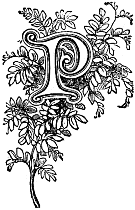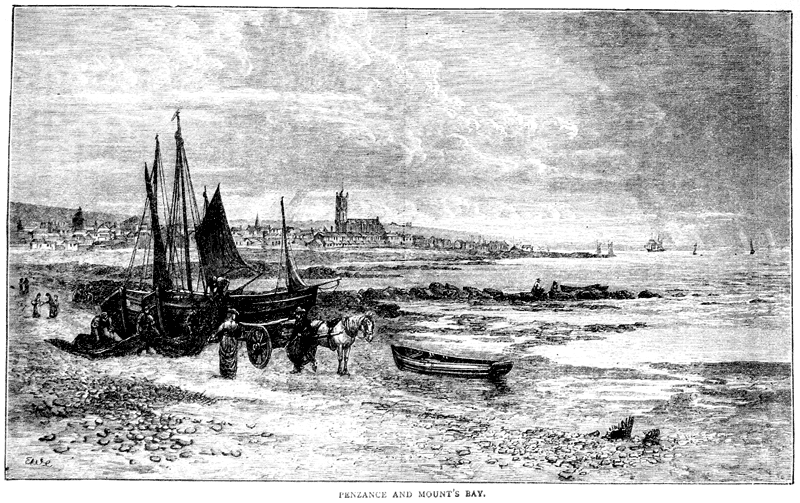 |

ERHAPS one of the most picturesque scenes in Cornwall
is that of the pilchard fleet going out in search of that welcome visitor to
the Cornish shores. Imagine a July sunset glowing in crimson and saffron on
Mount's Bay, and illumining the hulls and sails of the fishing boats starting on
their expedition - a long line extending seaward till they disappear in dim
perspective. They have started from the villages of Mousehole and Newlyn on
the western side of Mount's Bay, and on the beach stand their wives and children
wishing them good-speed. A lovely picture might be made of this departure.
The pilchards are the especial treasure of the Cornish fishermen; and when
tidings come of vast shoals of "the silvery fish having passed the Land's End
like a marine army, led by its chief, King Pilchard," the men of the coast are
eager to meet them. Immense quantities are taken, and bring comfort to many a
seaside home. There are even superstitions attached to these piscatory guests.
If, when they are packed side by side after salting, a loud noise is heard - the
breaking of the air-bladders in the fish - it is a good omen; they are thought to
be calling to more pilchards to
follow them. It is also considered unlucky to eat a pilchard from the head;
it should be eaten from the tail, say the fisher folk of Mousehole and Newlyn.
The enormous shoals generally go, one in the direction of Mount's Bay, the other
to St. Ives' Bay, where we are told a single haul was once made of 245,000,000
pilchards. Mousehole is a most picturesque village in a shadowy hollow, which
has also charmingly fantastic rocks, and a fine bay in front of it, with two
pieces of granite running out from it. St. Clement's Isle lies off the harbour;
once there was an oratory dedicated to St. Clement on its rocks. Mousehole was
formerly a market town, and was called Porth Enys. Its present strange name is
said to be a corruption of Moz Hel, the Maiden's River.
There is a cavern there of some size well worth visiting, and a quay was built
here in 1392. Here, rather more than a hundred years ago, died Dolly Pentreath,
at the age of 102, the last person supposed to have been able to speak the old
Cornish dialect. She is buried in the churchyard of St Paul's, a village close
by Mousehole, and Prince Lucien Buonaparte erected in it a monument to her
memory.
Not far from Mousehole is Lamorna Cove, a most lovely inlet of the sea, and the
valley is charmingly picturesque. Climbing the ascent Bolleit is reached, a
battle plain on which Athelstane defeated the Britons in a last desperate struggle for their
freedom. On the right of this road are some of the stones we have already
described. Athelstane, after he had subjugated Cornwall (even to the Scilly
Islands), founded a college for Augustine canons at Buryan. From thence we reach
the noble promontory of Treryn, crowned by the triple vallum and Posse of the
Giant's Castle, of which we have already spoken. Froth thence we ascend to the
Logan Stone, of which also we have spoken.
A little to the west of the Logan Stone, and beyond Treryn (pronounced Treen),
is Porthcurno Cove, one of the most picturesque of Cornwall's many lovely little
bays. It runs into a rock-piled coast, with golden sands before it (which are
really not sands, but minute shells), and with moors rising above it, which are
adorned with furze and purple with heath in summer, and veiled in gloom and mist
in winter. There was once a small chapel or oratory dedicated to St. Levan in
this cove (as there generally was in the others), but only a little square
enclosure now remains of it.
Looking up the valley, a few trees and the chimney-tops and part of the roof of
in old house are to be seen. It is Raftra House, once the largest mansion west
of Penzance; built, tradition says, by the Tressillians, a grand old Cornish
family, who, before it was finished, had, it is said, run through their
patrimony, and had to sell it and the lands for less than the building lead
cost them.
This valley (called the Bottoms) is a very weird, melancholy-looking place, with
much marshy ground in it; and few people care to cross it at night, it is so
lonely and dreary; it also bears the reputation of being haunted, as Croft Pasco
Pool is, by a ghostly vessel, and till quite of late years the tale was believed
by the fisher folk.
The apparition appeared on the sea about nightfall, when mists were rising from
the marshes in the Bottoms. It sailed through the breakers that foam over the
dangerous rocks that fringe the shore glided over the sands, and sailed on a
long way up the valley to Bodelan, or Bodellen, where St. Levan formerly dwelt;
it then directed its course to Chygwiden, and there utterly vanished. It was a
black, squarerigged, single-masted barque, and had usually, but not always, a
boat with it. No crew were ever seen; it is supposed they were down below. It
is said to be an ill omen to see this ghostly vessel, and that the sight of it
forebodes misfortune.
 The reason of its appearance is, according to tradition, that a stranger, many a
long year ago, returned from sea and took up his abode at Chygwiden. He had with
him a foreign servant, dark and evil looking, who never spoke to any one but his
master, being probably unable to speak English. It was whispered that the pair
had been Pirates or buccaneers. They, kept a boat in the cove, and would start
in it at daybreak, disappear out at sea, and never return till it was night;
nay, sometimes they remained out all night if the weather were stormy. At times
they remained on shore arid hunted, generally, however, at night, and in storms,
when the cry of the hounds, ringing out at midnight, would startle the sleeping
country.
The stranger died, and his coffin was carried by the peasants to the
churchyard, the servant and the dogs following it. But when the earth was
thrown into the grave, servant and dogs all disappeared, and were never seen
again. At the same moment their boat disappeared from the cove. Ever since that
time the ghostly vessel sails at certain periods in awful silence and mystery to
the pirate's grave.
Pursuing the same course as the phantom ship, and finally ascending some stone
steps, we reach the church of St. Levan, at the head of the green valley,
standing on the same spot as that where the saint had his cell. By his power the
dreary valley became, during his lifetime, a garden; for where his footsteps
fell, grass and flowers sprang up. He used to go fishing daily at
the headland of Pedn-men-an-mere, to which a footpath through the fields leads
from the church. There is a legend that one Sunday morning St. Levan was passing
over the stile to get some fish for dinner, when a woman named Johana, who was
in her garden by the pathway gathering potherbs, reproached him for fishing on
Sunday. The saint replied that mass was said, and that there was no more harm in
his getting his dinner from the sea than there was in her gathering potherbs for
her own. In fact, the saint never caught more than one fish, which sufficed for
his frugal meal.
He called her "foolish Johana," and said that if another of her name were ever
baptized in his well, she should be still more silly than Johana. On this
account no child of that name was ever christened at St. Levan's, but those who
wished to thus name their daughters took them to Sennen for baptism.
On the south side of the church, to the east of the porch, is a rock broken in
two, the fissure being full of ferns and wild flowers that grow in it, while
tall grass encompasses it. On this rock St. Levan was wont to sit and read and
meditate, or listen to the far-off moan of the sea.
He appears to have had a giant's strength, for one day he gave the stone a blow
with his fist and split it in two; then, bending over it, he uttered this
prophecy:-
The fissure does not seem to have opened much since the saint's day. There is
therefore no immediate chance of his prophecy being fulfilled.
Though St. Levan's Church is somewhat decayed, a little of the ornamental work
that adorned it is still to be seen. It consists of some curious carving, which
evidently at one time recorded the events in the life of the saint. There are
repetitions of one especial device; it is that of two fish on a hook. We have
already
mentioned that St. Levan, when he had caught one fish, did not attempt to take
more: his fishing was for food, not for sport. But one evening, when he was
catching his supper, there was a strong pull on his line, and on drawing it in
he found two breams on his hook. The good saint needed only one; but wishing to
be impartial, he would not keep either, but threw them both back into the sea.
Again they came on the hook, and were again thrown back; but when they appeared
on it a third time, St. Levan thought that there must be some reason for so
singular an occurrence, and carried them both home. When he reached his hut at
Bodellen, he found his sister, St. Breage, and her two children come to visit
him, and he was glad that he had caught two fish. They were cooked for supper.
The children had walked far, and were very hungry. They ate fast and carelessly,
and a bone stuck in the throat of each, and choked them. Since that time the
bream has been called by the fishermen of St. Levan "choke-child."
The ruins of the old well of St. Levan remain on the side of the stream that now
flows over it. It must have been his original baptistery.
There is a fine cross in the churchyard.
On this part of the coast are the
finest groups of rocks in the country. Tol-Pedn Penwith is wonderfully
picturesque. It is a grand mass of granite, broken and shattered, and full of
chasms, the rocks taking the most fantastic shapes. Seen from the beach, it is
magnificent. The cliffs from here to Paidenick are wonderful, and the whole
coast is of quite unrivalled sublimity.
The parish of St. Levan is named after the saint who built its church, and dwelt
among his people. Probably he cultivated flowers, and lived by fishing; and
this was ground enough for an affectionate and imaginative people to concoct the
legends that have gathered about his name.
The church of St. Just is on the northern coast of Penwidi. Penwith is the name
of the whole Land's End district, and includes all this western part of Cornwall.
The old grey towers of this church and of St.
Sennen's, rising amidst the moors and combes, are very picturesque objects in
the landscape.
|
 |